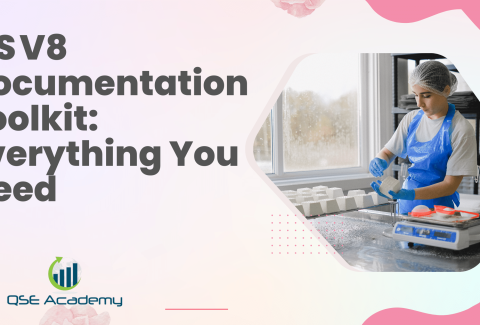IFS V8 Requirements: Chapter‑by‑Chapter Breakdown
Last Updated on November 20, 2025 by Melissa Lazaro
A Practical Guide to Understanding IFS V8
IFS V8 can feel overwhelming at first glance. The structure is dense, and the expectations are detailed. That’s why many companies struggle to understand how each chapter connects to real operational practice and audit readiness.
My experience supporting food businesses with IFS preparation, internal audits, and gap assessments has shown one thing consistently: when organizations understand the structure clearly, implementation becomes far more manageable. The goal isn’t just passing an audit—it’s building a system that ensures safe, consistent, and trusted products every day.
This guide walks through IFS V8 chapter by chapter, explaining what each section requires, how it fits into the bigger system, and what evidence demonstrates compliance. If you’re planning certification, upgrading from V7, or refining your current system, this breakdown gives you a clear starting point and an organized view of the standard’s expectations.
Chapter 1 — Governance & Commitment Requirements
This chapter sets the tone for the entire standard. It focuses on:
- Leadership involvement
- Accountability
- Alignment with legal and customer requirements
- Management review
- Commitment to food-safety culture
Auditors expect visible leadership engagement—not just signatures on policies. Responsibilities must be clear, measurable objectives must be defined, and performance must be reviewed based on evidence.
A single example stands out from my work: a business improved audit performance simply by documenting leadership walkthroughs, adding KPI reviews to management review, and tracking follow-up actions. The system didn’t change dramatically—visibility and consistency did.
 Chapter 2 — Food-Safety & Quality Management System
Chapter 2 — Food-Safety & Quality Management System
This chapter focuses on structure, control, and consistency. The system must:
- Define scope
- Include controlled documents and records
- Use structured procedures and work instructions
- Demonstrate change control
- Show continual improvement based on data
A functional Food-Safety and Quality Management System (FSQMS) is more than documents—it supports daily operations. If employees need multiple approvals to find the right form or procedure, the system isn’t effective.
Change control is a key area to strengthen. Any adjustment to the system—ingredients, equipment, specifications—should be evaluated for risk and documented.
Chapter 3 — Resource Management Essentials
IFS expects businesses to have the people, equipment, infrastructure, and support services required to operate safely. That includes:
- Competency-based training programs
- Documented hygiene rules and PPE requirements
- Calibration and equipment maintenance
- Adequate staffing levels
- Controlled utilities such as water, air, and steam
Competence isn’t proven by attendance—it’s demonstrated performance. A training matrix, skills evaluation, and documented supervision provide the evidence auditors look for.
Infrastructure, equipment, and hygiene rules must support controlled operations across all production shifts—not just the one visible during an audit.
Chapter 4 — Operational Process Controls
The expectations in this chapter connect directly to day-to-day execution. Key elements include:
- PRPs supporting hygienic manufacturing
- Recipe and processing controls
- Foreign-body and allergen management
- Traceability and product identification
- Label verification
- Rework and deviation management
Monitoring must occur at defined frequencies, using approved equipment, performed by trained personnel, and documented at the time of activity.
Traceability must function under real conditions. If retrieving records delays operations, the system needs refinement. Controls must be practical, repeatable, and aligned with operational risk.
Chapter 5 — Product Control
This chapter ensures the product consistently meets expectations through:
- Defined specifications
- Product release procedures
- Packaging controls
- Microbiological and chemical testing
- Claim and labelling accuracy
- Shelf-life validation
Any claim, especially allergen-free or certification-based claims, must be supported by clear evidence.
Shelf-life studies must be realistic, aligned with product behavior, and based on verified testing rather than assumptions or marketing targets.
Chapter 6 — Food Defence & Food Fraud Measures
This chapter focuses on preventing intentional contamination and economically motivated adulteration. The system must include:
- A food defence plan
- A vulnerability assessment for fraud
- Risk-based mitigation measures
- Verification activities
- Controlled access and security
Program effectiveness relies on reviewing market trends, ingredient risks, and supply-chain vulnerabilities. Controls must evolve when risks change, not only during annual review cycles.
Drills and testing demonstrate readiness—not just documentation.
Chapter 7 — Allergen Control, Claims & Product Integrity
IFS requires strong control for:
- Allergen handling and segregation
- Cleaning validation
- Changeover procedures
- Labelling and claim verification
Incorrect labels or inaccurate allergens are among the leading causes of recalls. Controls must be clear, repeatable, and verified.
Product integrity covers more than allergens. If a product claims “organic,” “gluten-free,” “Halal,” or “non-GMO,” the evidence must be traceable, controlled, and reviewed regularly.
Chapter 8 — Product-Safety Culture
Culture becomes measurable in IFS V8. Requirements include:
- Defined culture objectives
- Communication strategies
- Training and awareness reinforcement
- Performance monitoring
- Improvement actions
Culture isn’t motivational posters—it’s consistent behavior. Monitoring culture trends, employee feedback, internal audit insights, and operational KPIs supports continual maturity.
Connecting the Chapters — One System, Not Eight
Each chapter supports the next. Governance drives structure. Structure enables operations. Operations create product and performance evidence. Evidence drives improvement and culture maturity.
A simple way to think of IFS V8:
| Component | Focus | End Result |
|---|---|---|
| Leadership | Direction | Accountability |
| System | Structure | Consistency |
| Operations | Execution | Safety & Quality |
| Verification | Proof | Confidence |
| Culture | Behavior | Sustainability |
The standard is designed as a living system—not a checklist.
FAQs
Do all chapters apply to every site?
Core requirements apply universally. Scope may alter how some expectations are applied, but exclusions require justification.
How long does it take to implement IFS V8?
Timelines vary depending on maturity, documentation, and operational readiness. Many sites complete implementation within 3–12 months.
Is software required to meet the standard?
No. Software can help with record control and automation, but paper-based systems are acceptable if they’re controlled and consistent.
Conclusion — Clarity, Structure, and Confidence
IFS V8 is designed to protect product integrity, strengthen operational consistency, and build confidence with customers, regulators, and certification bodies. Understanding the structure makes implementation far more manageable and helps transform compliance into daily practice—not a once-a-year audit exercise.
If you’re continuing with implementation, the next logical step is mapping your current system against each chapter to identify gaps and priorities. When you’re ready, I can support that evaluation with clear steps and practical tools.
Melissa Lavaro is a seasoned ISO consultant and an enthusiastic advocate for quality management standards. With a rich experience in conducting audits and providing consultancy services, Melissa specializes in helping organizations implement and adapt to ISO standards. Her passion for quality management is evident in her hands-on approach and deep understanding of the regulatory frameworks. Melissa’s expertise and energetic commitment make her a sought-after consultant, dedicated to elevating organizational compliance and performance through practical, insightful guidance.







